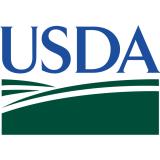Beneficial rains this past month provided significant relief to drought on the islands, in particular across the U.S. Virgin Islands.
Current drought conditions on the islands are expected to improve and/or be eliminated by the end of January.
Key Points
- Puerto Rico Conditions: October was quite wet across the eastern half of the island, as well as the southern coast. Several locations in Humacao Municipio saw over 12 inches of rain. As a result, drought was removed from eastern Puerto Rico. San Juan saw nearly 10 inches of rain (9.73 inches) in October, which is its wettest October since 2006, and nearly double the 30-year normal of 5.2 inches. With November typically being the wettest month of the year, the chances for drought expansion/development are very low in Puerto Rico through the end of 2023.
- U.S. Virgin Islands (USVI) Conditions: Recent rains significantly improved drought conditions across all three islands, with St. John now drought-free. Many locations in St. John saw an excess of 15 inches of rain in October, with a location in Cruz Bay reporting 17.75 inches, which is the wettest since 1984. Most locations in St. Croix saw 6–8 inches of rain in October, resulting in a 2-category improvement in drought conditions. On St. Thomas, rainfall totals were generally at least 160% of normal island-wide, with rainfall totals in the 8–12 inch range. Cyril King Airport saw 8.69 inches, which is its wettest October since 2010.
- Puerto Rico Impacts: The recent rains were beneficial to some aspects of farm production, and pastures recovered well. However, there are concerns of potential over-saturation of the soils as well as erosion and flooding if rains continue at high intensities. Streamflows in western Puerto Rico have not yet fully recovered.
- U.S. Virgin Islands (USVI) Impacts: Farmers and livestock farmers are still feeling the impacts of recent drought conditions, but recent rains helped with planting and cisterns are filling up.
- Looking Ahead: The National Weather Service Climate Prediction Center's seasonal outlook calls for additional improvements to drought conditions across Puerto Rico and the U.S. Virgin Islands.
- View active National Weather Service Drought Information Statements, including for Puerto Rico and the U.S. Virgin Islands.
- For weather information specific to your area, please monitor products issued by the National Weather Service in San Juan.
See below for additional details on rainfall, soil moisture, and streamflow conditions, impacts, and outlooks.
U.S. Drought Monitor map for Puerto Rico, as of October 31, 2023. The U.S. Drought Monitor is updated each Thursday to show the location and intensity of drought across the country.
The map uses 5 classifications: Abnormally Dry (D0), showing areas that may be going into or are coming out of drought, and four levels of drought (D1–D4).
U.S. Drought Monitor map for the U.S. Virgin Islands, as of October 31, 2023. The U.S. Drought Monitor is updated each Thursday to show the location and intensity of drought across the country.
The map uses 5 classifications: Abnormally Dry (D0), showing areas that may be going into or are coming out of drought, and four levels of drought (D1–D4).
U.S. Drought Monitor
D0 - Abnormally Dry
Abnormally Dry (D0) indicates a region that is going into or coming out of drought, according to the U.S. Drought Monitor. View typical impacts by state.
D1 – Moderate Drought
Moderate Drought (D1) is the first of four drought categories (D1–D4), according to the U.S. Drought Monitor. View typical impacts by state.
D2 – Severe Drought
Severe Drought (D2) is the second of four drought categories (D1–D4), according to the U.S. Drought Monitor. View typical impacts by state.
D3 – Extreme Drought
Extreme Drought (D3) is the third of four drought categories (D1–D4), according to the U.S. Drought Monitor. View typical impacts by state.
D4 – Exceptional Drought
Exceptional Drought (D4) is the most intense drought category, according to the U.S. Drought Monitor. View typical impacts by state.
U.S. Drought Monitor
D0 - Abnormally Dry
Abnormally Dry (D0) indicates a region that is going into or coming out of drought, according to the U.S. Drought Monitor. View typical impacts by state.
D1 – Moderate Drought
Moderate Drought (D1) is the first of four drought categories (D1–D4), according to the U.S. Drought Monitor. View typical impacts by state.
D2 – Severe Drought
Severe Drought (D2) is the second of four drought categories (D1–D4), according to the U.S. Drought Monitor. View typical impacts by state.
D3 – Extreme Drought
Extreme Drought (D3) is the third of four drought categories (D1–D4), according to the U.S. Drought Monitor. View typical impacts by state.
D4 – Exceptional Drought
Exceptional Drought (D4) is the most intense drought category, according to the U.S. Drought Monitor. View typical impacts by state.
U.S. Drought Monitor map for Puerto Rico, as of October 31, 2023. The U.S. Drought Monitor is updated each Thursday to show the location and intensity of drought across the country.
The map uses 5 classifications: Abnormally Dry (D0), showing areas that may be going into or are coming out of drought, and four levels of drought (D1–D4).
U.S. Drought Monitor map for the U.S. Virgin Islands, as of October 31, 2023. The U.S. Drought Monitor is updated each Thursday to show the location and intensity of drought across the country.
The map uses 5 classifications: Abnormally Dry (D0), showing areas that may be going into or are coming out of drought, and four levels of drought (D1–D4).
The U.S. Drought Monitor is updated weekly on Thursday morning, with data valid through that Tuesday at 7 am Eastern.
The U.S. Drought Monitor is updated weekly on Thursday morning, with data valid through that Tuesday at 7 am Eastern.
Current and Future Drought Conditions
Drought Conditions
- Puerto Rico: Less than 3% of Puerto Rico is currently considered in drought (D1) according to the U.S. Drought Monitor, with an additional 25% of the island categorized as Abnormally Dry (D0).
- U.S. Virgin Islands: According to the U.S. Drought Monitor, both St. Thomas and St. Croix are experiencing Severe Drought (D2), which is a two-category improvement over the past month. St. John is now considered drought-free.
Sector Impacts
Agricultural Conditions
- Puerto Rico:
- Farmers from the coastal North Region (Toa Alta and Arecibo Municipality) reported a few more rains in the last weeks. They delayed some farm tasks due to the rain.
- In the Central Region (Barranquitas, Cidra, Caguas, Las Piedras, Naguabo Municipalities), farmers experienced changes in dry patterns. Since mid-September, there was an increase in rain. The humidity and the rain, in addition to the high heat, made some farm tasks and production difficult. Some farmers have started to cease operations in the afternoon and continue working after 4 p.m., when temperatures decrease (especially for the Caguas Municipality).
- Farmers from the Eastern Region (Las Piedras, Naguabo, Gurabo, Carolina, Yabucoa) experienced more rain in the past weeks. Even though it has been beneficial to farm production, some fear that the intensity of the rain and over-saturation may affect planting calendars. Farmers in the Yabucoa Municipality ceased planting operations due to the rain. Precipitation in Las Piedras Municipality resulted in erosion, flooding, and landslides near riversides.
- Ranchers in the Southwest Region (Cabo Rojo and Lajas) report that the rains continued over the past few weeks consistently. In October they reported more than 10 inches of rain, and in September around 6 inches. The pastures recovered and are in excellent condition in terms of quality and quantity. The cows are in excellent condition as well. Ranchers did not have to supplement their feed with hay.
- St. Thomas: Farmers in St. Thomas report ponds are bouncing back with rain, and this precipitation is helping their cisterns and storage recharge. Many began to plant and prepare irrigation to better manage water as part of long-term conservation plans. Farmers are doing what they can to keep orchards and fruit trees watered at this time, and livestock farmers are rotating livestock and separating males and females to reduce births to save on forage in the summer months.
- St. John: Row and specialty crop farmers on St. John report that they received much-needed rain, and crops are now bouncing back slowly. Most are focusing on microgreens, fruit trees, and quick crops to keep production up and rotating crops. Many are also preparing land for when they will increase production and make up sales lost during the recent severe drought.
- St. Croix: Farmers saw rain, and many report these intermittent showers are helping them to plant. Poultry farmers also report production is still low, and poultry are still molting. Farmers reported Guinea grass is bouncing back which may help. Farmers who have poultry, including both broilers and/or egg production, have smaller numbers because they must collect water in containers or use cistern water for the poultry during drought and the dry season. This helps them to plan and conserve so they have access to water during the heat. Most poultry farmers still reported low production. The U.S. Virgin Islands Department of Agriculture (VIDA) reported that more than 660,060 gallons of water were delivered for the month of October, as of October 30, 2023. This amount is a significant reduction in water usage from September, which was 1,097,690 gallons.
- Assistance for USVI farmers and ranchers: According to the U.S. Department of Agriculture, St. Croix and St. Thomas already qualified for a 2023 secretarial drought disaster declaration, based on the U.S. Drought Monitor (USDM). Similarly, livestock producers in St. Croix and St. Thomas qualified for direct assistance through the USDM-driven Livestock Forage Program (LFP). LFP assistance begins when Severe Drought (D2) lasts 8 weeks or more, with payments tripling when the Extreme Drought (D3) threshold is reached, and quadrupling upon spending 4 weeks at D3 or attaining Exceptional Drought (D4).
Rainfall Trends
The 60-day rainfall deficits range between 2 and 4 inches across most of Puerto Rico, with rainfall deficits between 8 and 12 inches in the vicinity of Lares, Arecibo, and Utuado.
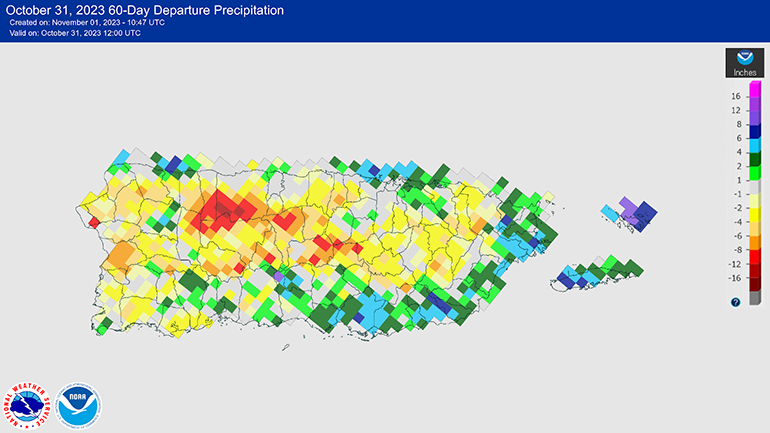
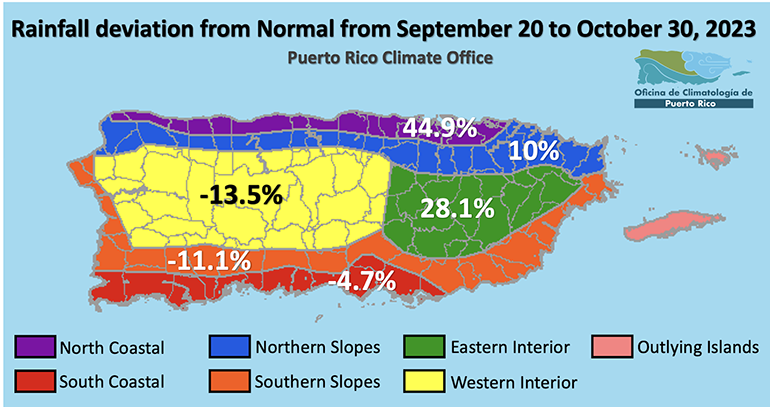
Soil Moisture Conditions in Puerto Rico
The latest soil moisture data from the Puerto Rico Agricultural Water Management (PRAGWATER) indicates improvements across Puerto Rico (Figures 3 and 4). However, the improvements have not been reflected in the streamflows, particularly across western Puerto Rico.
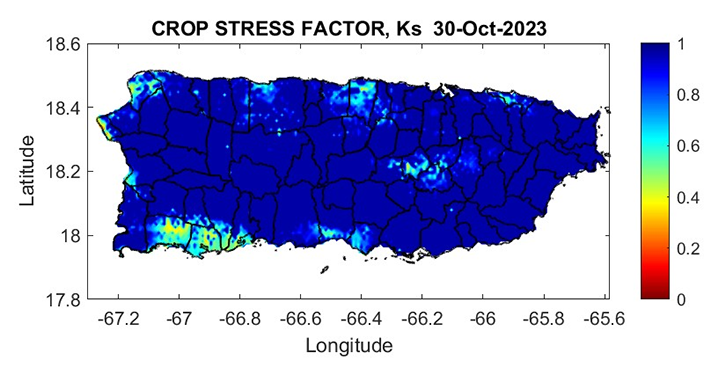
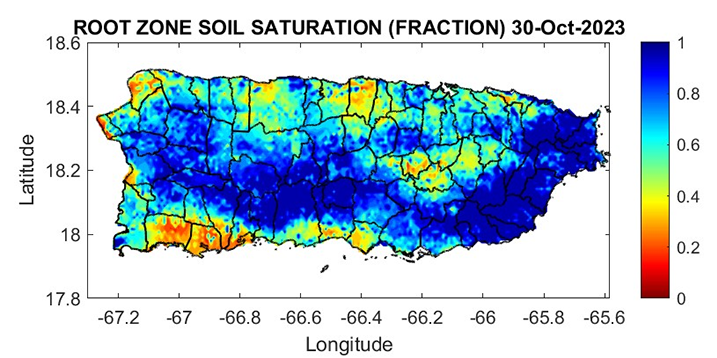
Streamflow and Reservoir Conditions in Puerto Rico
The real-time 28-day average streamflow from the U.S. Geological Survey (USGS) river gauge network (Figure 5) indicates low streamflows across western portions of Puerto Rico and in a few spots across the eastern interior. View information on groundwater levels along the South Coast of Puerto Rico.
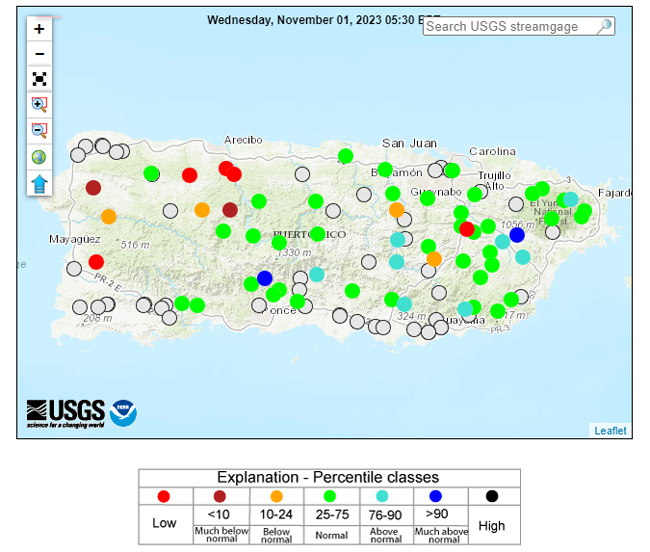
Outlooks
Seasonal Drought Outlook
The Climate Prediction Center's seasonal drought outlook (Figure 6) calls for improvements across the local islands.
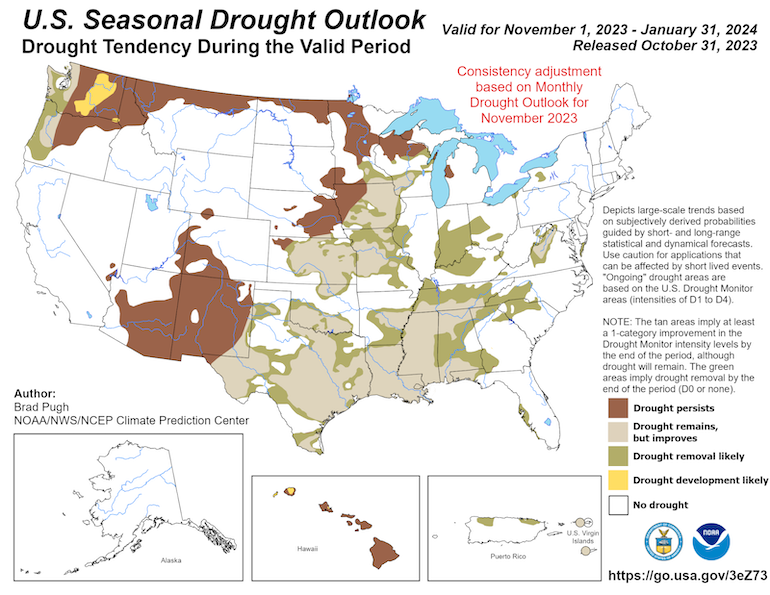
For More Information
- National Weather Service (NWS) Weather Forecast Office – San Juan: Climate and Drought Information
- NWS Drought Information Statements for Puerto Rico and the U.S. Caribbean
- Drought.gov:
- Caribbean Drought Bulletins. Caribbean Regional Climate Center, Caribbean Institute for Meteorology and Hydrology (CIMH), Barbados
- U.S. Department of Agriculture (USDA) Caribbean Climate Hub drought and disaster assistance resources for tropical forestry and agriculture
Prepared By
Odalys Martinez and Emanuel Rodriguez
National Weather Service San Juan Weather Forecast Office
Héctor J. Jiménez
Office of Climatology, University of Puerto Rico
Meredith Muth
NOAA National Integrated Drought Information System (NIDIS)
Victor Murphy
National Weather Service Southern Region
Christina Chanes
University of Virgin Islands
Silmarie Crespo Vélez and Nora Álvarez-Berríos
USDA Caribbean Climate Hub, USFS International Institute of Tropical Forestry
Brad Rippey
USDA Office of the Chief Economist
Timothy Dalrymple
USGS Caribbean – Florida Water Science Center (CFWSC)
Puerto Rico Reporting Input: Thanks to the Agricultural Extension Service, College of Agricultural Sciences, University of Puerto Rico-Mayaguez, South West Soil and Water Conservation District, and the Association of Cattle Ranchers. Special thanks to agronomists, ranchers, and farmers: Gabriela Álvarez, Merari Torres Amaro, Gabriela Cotto Santos, Santiago Acosta, Sebastián Díaz, Frankie Adalberto, and others.
USVI Reporting Input: Several individuals contributed to this report and we are acknowledging the following for their support including the farming community across the USVI, UVI faculty, staff, and collaborators of the UVI School of Agriculture, UVI Physics Program, UVI Etelman Observatory, UVI Agricultural Experiment Station, VI Department of Agriculture, as well as the USDA Office Chief Economist, National Parks Service in St. Croix, VI Department of Planning and Natural Resources, USDA Farm Service Agency, Coral Bay Community Council and the many volunteer drought reporters and farmers from across the territory.
About This Report
This drought update is issued in partnership between the National Integrated Drought Information System (NIDIS), National Oceanic and Atmospheric Administration (NOAA) National Weather Service, the U.S. Department of Agriculture (USDA), and the University of the Virgin Islands. The purpose of the update is to communicate a potential area of concern for drought expansion and/or development within Puerto Rico and the U.S. Virgin Islands based on recent conditions and the upcoming three-month forecast.
NIDIS and its partners will issue these updates every two months. Subscribe for these U.S. Caribbean drought updates here.





